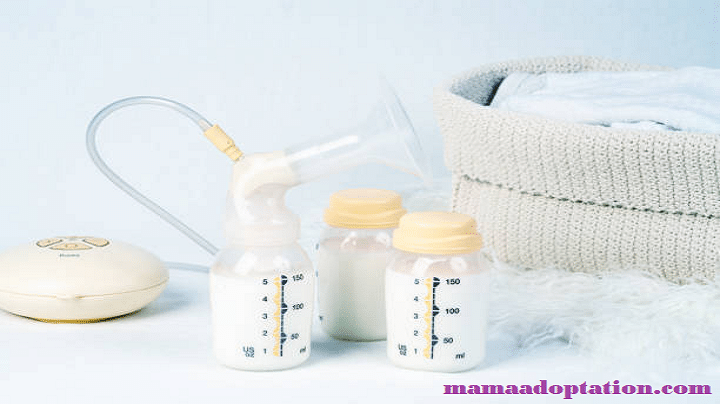Breast pumping is a process of extracting milk from a woman’s breasts. Breast pumps are machines used to do this. They come in all shapes and sizes, but the most common type is an electric pump.
There are different types of breast pumps for other purposes, such as expressing milk for feeding newborns or for people who have difficulties expressing milk through breastfeeding…
What to consider before setting up your breast pumping station?
You have probably heard that breastfeeding is the best way to feed your baby and that it’s essential to establish a good nursing relationship. But what if you can’t breastfeed? Consider breastfeeding pumping as an option. Here are some things to consider before setting up your pumping station:
Multifunctional:
It is important to remember that a breastfeeding mother’s pumping station should be multifunctional to provide her with all the tools she needs to breastfeed successfully. This means having a place for her to store her pump, bottles, and other materials while she is pumping, as well as a place to sit or recline while she is doing so.
Some mothers find it helpful to have a small table near their bed to set down their pumps and bottles while nursing. Other mothers prefer a portable pumping station, such as the Medela Pump In Style Advanced or the Ameda PureForme Electric Breast Pump, which they can take with them wherever they go.
Whatever configuration works best for you will depend on your individual needs and preferences.
Comfort:
Regarding comfort, there’s something to be said about having everything laid out in advance. That’s why we recommend setting up your breast pumping station ahead, so you’re all set when the time comes. Here are a few tips to make the process as smooth as possible:
- Choose a location that’s comfortable for both you and your baby. You’ll both be happier if you can relax while pumping.
- Make sure the space you choose is well-lit and has plenty of storage space for your supplies. You’ll want enough room to store your pump, bottles, and breast milk storage containers.
- Consider adding a footrest or other seating option to rest while pumping. This will help increase your efficiency and reduce stress.
Kid-Friendly:
When you are ready to set up your breast pumping station, it is essential to consider what is comfortable for your baby and yourself. There are many different types of breast pumps on the market today, so you can find one that is both functional and stylish. Some tips to keep in mind when setting up your station include:
- Choose a comfortable location for you and your baby. You will spend a lot of time sitting close to this station, so make sure the space is comfortable. Try to find a spot where no distractions, such as TVs or other children playing.
- Choose an area that’s easy to clean. Make sure there is enough space near the pump to scrub down after each use. Also, consider locating the pump near a sink so you can quickly rinse any milk residue.
Multiple Stations:
When choosing where to set up your breast pumping station, you must consider your needs as a breastfeeding mother. If you are exclusively breastfeeding, for example, you may need access to a private area where you can pump without interruption. However, if you are supplementing with formula or human milk from other sources, a more public setting may be preferable.
Breast Pumping Station Storage and Organization Ideas
There is no right way to store and organize a breast pumping station. However, some ideas to get you started include:
- Creating a designated area in your home for the station, whether it’s in a corner or on an elevated surface, so that you have easy access when you need it
- You use a cabinet or drawer system to organize your supplies, such as pumps, bottles, gloves, etc.
- Stock up on storage containers that can be used for storing milk (such as glass or plastic jars), and designate one spot on your wall where you can hang them up
- Create a “breast pump essentials” basket with disposable nursing pads, wipes, cups, and bottles.
Minimum Essentials for a Breast Pumping Station:
An adequate breast milk supply is essential for a Breast Pumping Station. Mothers should pump at least eight times daily to produce enough milk to feed their infants on demand. A good rule of thumb is to pump two ounces per feeding, so if a mother pumps eight times per day, she should produce 64 ounces of breast milk daily.
Breastpump:
A good breast pump will allow you to produce enough milk for your baby quickly and easily. Some pumps come with storage containers to keep your milk fresh while you’re away from home. There are many factors to consider when buying a breast pump, including price, features, and portability.
If you’re looking for a quality breast pump that won’t break the bank, we recommend the Medela Pump in Style Advanced Breast Pump. This pump has all the features you’ll need, and it’s easy to store thanks to its included carrying case.
Milk Storage Bags or Containers:
Breastfeeding mothers should also consider
Purchasing a pump and storage container set. This way, they can pump and store
Breast milk simultaneously without carrying multiple pieces of
Equipment around.
Some breastfeeding mothers choose to freeze their milk for future use. Pumping
into storage containers allows mothers to consume their frozen milk as needed
without thawing and refreezing it each time.
Permanent marker:
There is no better way to make Breast pumping more comfortable and convenient than with a permanent marker. They come in handy for labeling bottles, cups, and other breastfeeding supplies, and they can also be used to write on skin or paper for easy reference. Here are some reasons why a permanent marker is essential for any Breast Pumping Station:
- They’re easy to store and access – Permanent markers are small and easily stored away in a desk drawer or cabinet. Plus, since they come in different colors, you can quickly and easily identify the one needed for each task.
- They’re versatile – Permanent markers can be used on many surfaces, including skin, paper, and even plastic bottles. This makes them perfect for labeling bottles, cups, nipples, filters…you name it!
Snacks:
Snacks are essential for a breastfeeding mother, as they provide nourishment and help to keep the mother’s energy level up while she pumps. Some good snacks to have on hand are hard-boiled eggs, yogurt, trail mix, and fruit. If pumping at home, some mothers like to bring along a thermos of hot coffee or tea.
Nipple cream:
Nipple cream is a gentle ointment that helps relieve pain and inflammation in the nipples during breastfeeding. It also helps keep them soft and supple. If you’re using a breast pump, keep some nipple cream on hand to apply before pumping. You’ll find that it makes smooth, efficient pumping much more comfortable.
Quick Tips on Pumping Milk:
When it comes to pumping milk, there are a few quick tips that will make the process go more smoothly.
- Make sure you have all the necessary equipment before you start. This includes a good pump, storage bags, and a place to store the milk.
- Pumping should be done at around the same time daily to maintain consistency.
- Always warm the milk before pumping to avoid cold spots that can cause latching problems.
- Try to alternate between breasts when pumping to keep them both stimulated and provide maximum milk production.
- Don’t over-pump your breasts; if you are producing more milk than your baby needs, release some of it into storage instead of pumping again.
- If you have any questions or problems while pumping, consult your doctor or lactation consultant for help.
Conclusion:
It is essential to have a pumping station to provide lactating women with uninterrupted access to breast milk. This will help improve their feeding and sleeping patterns, as well as their overall health and well-being. If you are a lactating woman and want to set up a pumping station at your home, please get in touch with a lactation consultant or nurse for assistance.
Read more…








